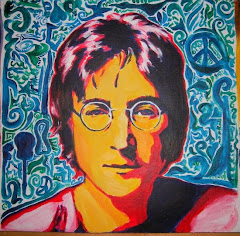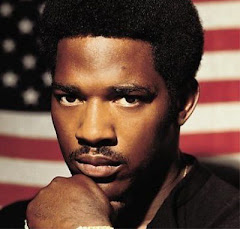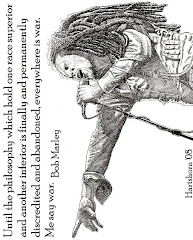Monday, September 22, 2008
Imagery in "Chimes of Freedom"
There are several examples of the use of imagery in "Chimes of Freedom." One phrase showing Dylan's use of this literary term is "Far between sundown's finish an' midnight's broken toll." From reading this, the reader can imagine the time between sundown, where the sky is beginning to become darker, and the black sky of midnight. Another example is "As the echo of the wedding bells before the blowin' rain," where Dylan describes the bells as wedding bells, which the reader can understand to be deep, low tones, which are echoing. Bob Dylan also further describes the rain as blowing rain, which the reader can imagine as if there is a wind. "Through the mad mystic hammering of the wild ripping hail" is yet another example of imagery, allowing the reader to imagine harsh hail that is hammering against roofs, windows, and cars. Finally, an exemplary example of imagery in "Chimes of Freedom" is the phrase "a cloud's white curtain in a far-off corner flashed/An' the hypnotic splattered mist was slowly lifting/Electric light still struck like arrows." The reader can imagine a "white curtain" of clouds in a corner of the sky as he or she is reading the lines, though when continuing to read the verse, is then able to imagine a rising mist; by the end of this phrase, the reader is thinking of lightening bolts ripping across the sky as if they were arrows. Throughout the song, the reader is constantly being led to imagine different scenes in order to heighten the experience of listening to the song.
Though the use of imagery is prevalent in song writing, such as in Bob Dylan's song "Chimes of Freedom," it can also be found in other forms of writing. Newspaper articles, for example, uses imagery to recreate a scene from the news, whether it be a high school football game or a car accident. Authors also use imagery to catch the reader's attention as well as to keep his or her interest. Imagery is found in everyday life and used for innumerable reasons.
Friday, September 19, 2008
"Chimes of Freedom" by Bob Dylan (1964)
We ducked inside the doorway, thunder crashing
As majestic bells of bolts struck shadows in the sounds
Seeming to be the chimes of freedom flashing
Flashing for the warriors whose strength is not to fight
Flashing for the refugees on the unarmed road of flight
An' for each an' ev'ry underdog soldier in the night
An' we gazed upon the chimes of freedom flashing.
In the city's melted furnace, unexpectedly we watched
With faces hidden while the walls were tightening
As the echo of the wedding bells before the blowin' rain
Dissolved into the bells of the lightning
Tolling for the rebel, tolling for the rake
Tolling for the luckless, the abandoned an' forsaked
Tolling for the outcast, burnin' constantly at stake
An' we gazed upon the chimes of freedom flashing.
Through the mad mystic hammering of the wild ripping hail
The sky cracked its poems in naked wonder
That the clinging of the church bells blew far into the breeze
Leaving only bells of lightning and its thunder
Striking for the gentle, striking for the kind
Striking for the guardians and protectors of the mind
An' the unpawned painter behind beyond his rightful time
An' we gazed upon the chimes of freedom flashing.
Through the wild cathedral evening the rain unraveled tales
For the disrobed faceless forms of no position
Tolling for the tongues with no place to bring their thoughts
All down in taken-for-granted situations
Tolling for the deaf an' blind, tolling for the mute
Tolling for the mistreated, mateless mother, the mistitled prostitute
For the misdemeanor outlaw, chased an' cheated by pursuit
An' we gazed upon the chimes of freedom flashing.
Even though a cloud's white curtain in a far-off corner flashed
An' the hypnotic splattered mist was slowly lifting
Electric light still struck like arrows, fired but for the ones
Condemned to drift or else be kept from drifting
Tolling for the searching ones, on their speechless, seeking trail
For the lonesome-hearted lovers with too personal a tale
An' for each unharmful, gentle soul misplaced inside a jail
An' we gazed upon the chimes of freedom flashing.
Starry-eyed an' laughing as I recall when we were caught
Trapped by no track of hours for they hanged suspended
As we listened one last time an' we watched with one last look
Spellbound an' swallowed 'til the tolling ended
Tolling for the aching ones whose wounds cannot be nursed
For the countless confused, accused, misused, strung-out ones an' worse
An' for every hung-up person in the whole wide universe
An' we gazed upon the chimes of freedom flashing.
Sunday, September 14, 2008
The Allman Brothers Band's contribution to the practice of song-writing
Even though many of their songs were instrumental, the Allman Brothers Band contributed greatly to the practice of song-writing. The band had incorporated elements of hard rock and blues-rock in their music, and was also considered as the "principle architects of Southern rock." The band’s debut album The Allman Brothers Band had few listeners due to the fact that it had mostly a blues-rock sound, though it attracted a small, cult-like following. The band's live album At Fillmore East showcased its unique mixture of not only hard rock and blues, but also jazz and even classical music. This album was a huge success, eventually being named as one of Rolling Stone's 500 Greatest Albums of All Time.
One of the band's later albums Eat a Peach was yet another hit. One writer, Greil Marcus, had described parts of the album as "ageless, seamless... front-porch music stolen from the utopia of shared southern memory." The Allman Brothers Band's success being a Southern rock band in the early 1970s led to the prominence of several other Southern rock groups, including the Marshall Tucker Band and Lynyrd Skynyrd. Several songs by the Allman Brothers are used in various television programs and advertising campaigns. Throughout the years, the Allman Brothers Band has experienced much success and critical acclaim, including being inducted into the Rock and Roll Hall of Fame. The band continues to tour and record music to the present day.
Song Analysis of "The Whipping Post"
At one point or another in a person’s life, the person they love will hurt them or they may even feel trapped in a relationship. Many artists incorporate these experiences in their music, showing that this predicament is universal. "The Whipping Post" by the Allman Brothers Band is a prime example in describing how a person feels when trapped in a relationship.
In the first verse, the singer describes how a person may feel when their loved one is mistreating them by saying, "I been run down, I been lied to/I don't know why I let that mean woman make me a fool...Now she's with one of my goodtime buddies/They're drinkin' in some cross-town bar" (1-5). This man feels terrible because the woman he is in a relationship with has lied to him and is cheating with one of his friends, making him feel foolish for believing in her. Every time this man finds out his girlfriend has lied to him, he says he feels as if he's "been tied to the whipping post" (7). This, of course, is a simile; the singer is describing his pain as if every time she lies a whip is lashing him. However, no matter how painful it is to be in this relationship, he has "to stand by and take it...all for lovin' [her]" (12); he loves his girlfriend so much that he will not leave her and he continues to endure the pain she causes him. The singer further elaborates by saying, "[I] drown myself in sorrow, and I look at what you've done/But nothin' seems to change, the bad times stay the same/And I can't run" (13-15). These lines explain that as he reflects on his relationship with his girlfriend, he realizes that it has not gotten better but it continues to stay terrible; he feels trapped by this relationship and he cannot get out.
Life is never what you would imagine it to be, and we will not love all the situations we are put in. A relationship may not always be pleasant, and if you love the person, sometimes saying goodbye can be difficult or even impossible. Many of us are put in this position, no matter how much we try to avoid it. "The Whipping Post" shows us that no one is immune to a relationship in which he or she may feel trapped, and the Allman Brothers Band does a fantastic job in showing that this dilemma can happen to anyone.
"The Whipping Post" by The Allman Brothers Band
I don't know why I let that mean woman make me a fool.
She took all my money, wrecked my new car.
Now she's with one of my goodtime buddies,
They're drinkin' in some crosstown bar.
Sometimes I feel, sometimes I feel,
Like I been tied to the whipping post,
Tied to the whipping post,
Tied to the whipping post,
Good Lord, I feel like I'm dyin'.
My friends tell me, that I've been such a fool,
And I have to stand by and take it baby, all for lovin' you.
Drown myself in sorrow, and I look at what you've done.
But nothin' seems to change, the bad times stay the same,
And I can't run.
Sometimes I feel, sometimes I feel,
Like I been tied to the whipping post
Tied to the whipping post,
Tied to the whipping post,
Good Lord, I feel like I'm dyin'.
Sometimes I feel, sometimes I feel,
Like I been tied to the whipping post
Tied to the whipping post,
Tied to the whipping post,
Good Lord, I feel like I'm dyin'.
Friday, September 12, 2008
The Allman Brothers Band: Timeline
.jpg) March 25, 1969: The Allman Brothers Band forms in Jacksonville, Florida.
March 25, 1969: The Allman Brothers Band forms in Jacksonville, Florida.November 8, 1969: The Allman Brothers Band’s self-titled debut is released on Capricorn Records.
March 12-13, 1971: The Allman Brothers Band are recorded at Bill Graham’s Fillmore East; the best performances are used in the album classic The Allman Brothers Band at Fillmore East.
October 29, 1971: Duane Allman, guitarist and founder of the Allman Brothers Band, dies in a motorcycle accident in Macon, Georgia.
February 12, 1972: Eat a Peach by the Allman Brothers Band is released. This album features the last studio recordings by Duane Allman.
November 11, 1972: Berry Oakley, the bassist of the Allman Brothers Band, dies in a motorcycle accident three blocks from Duane Allman’s fatal crash that occurred a year earlier.
July 28, 1973: The Band, the Grateful Dead, and the Allman Brothers Band perform for a crowd of 600,000 at the Watkins Glen “Summer Jam.”
August 25, 1973: The Allman Brothers Band releases Brothers and Sisters; it is their highest charting (#1) and longest charting (56 weeks) album.
November 3, 1973: The Allman Brothers Band's Ramblin’ Man reaches #2, making it the highest-charting single of their career.
May 12, 1976: The Allman Brothers Band temporarily dissolves.
February 13, 1979: The reunited Allman Brothers Band release Enlightened Rogues.
January 23, 1982: The Allman Brothers Band perform on ‘Saturday Night Live,’ their last performance for four years.

May 14, 1989: Dreams, a box set spanning The Allman Brothers Band’s career, is released.
June 1989: Warren Haynes (guitar) and Allen Woody (bass) join The Allman Brothers Band.
June 19, 1991: The Allman Brothers Band releases Shades of Two Worlds.
April 26, 1994: Where It All Begins, an album of The Allman Brothers Band's new material, is released.
January 12, 1995: The Allman Brothers Band is inducted into the Rock and Roll Hall of Fame.
1996: The Allman Brothers Band won the Grammy Award for Best Rock Instrumental Performance for "Jessica."
March 16, 1999: The Allman Brothers Band begins their 30th anniversary tour with eighteen nights at the Beacon Theater in NYC.
August 26, 2000: The bass player for the Allman Brothers Band and Gov’t Mule, Allen Woody, dies.
November 14, 2000: The Allman Brothers Band’s Peakin’ at the Beacon, a live album recorded at Beacon Theater, is released.
2003: Duane Allman, Warren Haynes, Dickey Betts, and Derek Trucks are added to Rolling Stone Magazine's list of 100 Greatest Guitarists of All Time.
2004: The Allman Brothers band is ranked 52nd on Rolling Stone's list of the 100 Greatest Artists of All Time.
From: Rock and Roll Hall of Fame: The Allman Brothers Band
Thursday, September 11, 2008
The Allman Brothers Band: Most Interesting Facts
-In 2004, Rolling Stone ranked them 52nd on their list of the 100 Greatest Artists of All Time.
-Rolling Stone listed The Allman Brothers' album At Fillmore East as one of Rolling Stone’s 500 Greatest Albums of All Time.
-Duane Allman was killed in a motorcycle accident on October 29, 1971 and just over a year later another band memeber, Berry Oakley, died in a motorcycle accident only three blocks from the site of Duane's accident.
-Gregg Allman married Cher; they eventually separated.
 -The band was inducted into the Rock and Roll Hall of Fame in 1995.
-The band was inducted into the Rock and Roll Hall of Fame in 1995.-They won the Grammy Award for Best Rock Instrumental Performance for "Jessica" in 1996.
-Rolling Stone Magazine added Duane Allman, Warren Haynes, Dickey Betts, and Derek Trucks to their list of 100 Greatest Guitarists of All Time in 2003, with Allman coming in at #2 and Trucks being the youngest guitarist on the list.
-The band has played the 2900-seat Upper West Side Manhattan theatre 173 times since 1989 in a tradition known as the "Beacon Run" among fans; people travel from across the United States, Canada and Western Europe to see these annual March and April shows.
-The band continues to record and tour to the present day.













